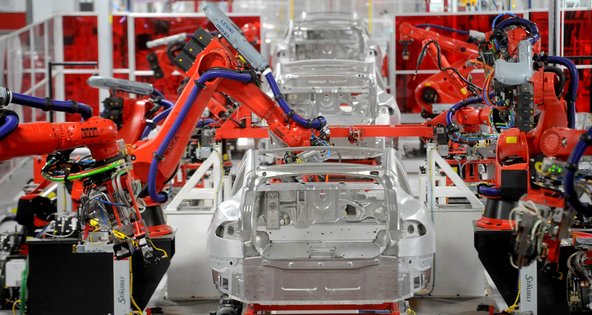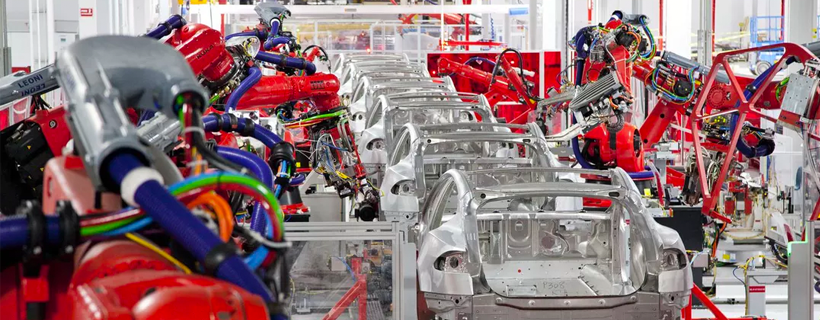I always wanted to cover Tesla, but as an internet analyst, the stock fell outside of my coverage space. Despite this, I continued to study the company and ultimately invested because I believe that Tesla is not a car company, but a consumer electronics company that thinks like an internet company. With a bedrock in AI and robotics, Tesla is one of the best positioned companies to transform our lives over the next 20 years. We think Tesla is on par with Amazon when it comes to a reckless pursuit to shape the future, which we believe will reward investors over the long run.
The Street Is Understandably Focused On The Wrong Metric
Tesla reports December quarter results on Wednesday (Feb. 22). Given the 48% rise in TSLA shares over the past 3 months, now trading near an all-time high, it’s understandable why investors are nervous going into the print. After all, good news is priced in as information of the earlier-than-expected Fremont production retooling has stoked Model 3 production expectations. As of our last check, buy side investors expect 17k to 25k Model 3 shipments in 2017. That’s a big number when you consider that in 2016 Tesla delivered 76k vehicles (all models) to customers. Investors will be zeroed in on Elon Musk’s comments on the earnings call about production of the Model 3 in 2017. His comments may cause volatility in the stock short term, but they are irrelevant in the long run.
It’s Not About How Many Model 3’s Tesla Sell In 2017
As venture capitalists, we have the luxury of thinking about themes over a very long horizon. With that perspective, Wednesday’s Tesla earnings report is a non-event. What’s more important is that Tesla makes the best car in the world, amplified by AI and robotics. That focus will keep competitors in check, allowing the company to reach scale and ride the next tech mega wave as our lives are quickly transformed (over the next 20 years) into an electric, automated existence.
Artificial Intelligence
Tesla’s obvious AI play is autopilot for autonomous vehicles, with a less well known AI push in manufacturing. We know that the company is pushing boundaries to gain data to improve its driving AI with a goal of being first to market with an L4 compatible vehicle (the automated system can control the vehicle in all but a few environments).

The first to market will have a measurable advantage because road data equates to smarter AI and safer cars. Google’s Waymo has driven over 2 million autonomous miles, but comparisons with other automotive companies are difficult given some companies include simulation miles. Last October, Elon Musk reported Tesla had driven 222 million cumulative autopilot miles, but those miles are not comparable to the fully autonomous number that Waymo reports. It’s unlikely that Waymo will have a commercially available vehicle in 2019, but likely that Tesla models solid in 2019 will be L4 compatible. Traditional automotive is even further behind, with BMW, Audi, Mercedes, Ford and GM likely shipping L3 autos in 2019. Note that L5 is the highest level of autonomy, for vehicles capable of all aspects of the dynamic driving under all roadway and environmental conditions that can be managed by a human driver, followed by L4, L3 and so on. This begs the question, why would anyone interested in an autonomous car buy an L3 compatible vehicle if it was priced similar to an L4 vehicle? We don’t know how Tesla’s autopilot AI stacks up against the market, but based on comments from our industry contacts, Tesla sees AI as one of its two core competencies and is structuring its future around it.
Traditional Auto Is Behind; Needs To Get Right With Electric Before Tackling Autonomy
To underscore how far behind traditional auto makers are in building the future of transportation, keep in mind those companies are still bracing for a post ICE (internal combustion engine) world. Spare parts and supply chain represent two profitable segments that traditional auto must give up. As for spare parts, an electric world lacks this gravy train. For example a Tesla Model S has 17 moving drivetrain parts, compared to a typical ICE vehicle with about 1,500 parts. Fewer moving parts means fewer repairs. The automotive supply chain is similar to the military spending complex, littered with special interests that will resist change. While big auto is easing into electric, Tesla was built for a post-ICE world and has already shifted its focus to AI (and as a result, autonomy) allowing the company to more aggressively pursue a self-driving world.
The core issue is innovation. Automotive companies are not tech companies; with autonomy on the horizon, they face the wrath of the innovators dilemma. Ford acquiring Argo is a step in the right direction, but will only be successful if Argo triggers a wholesale change in the pace with which Ford embraces EV and autonomy. We believe that it’s unlikely children born in the US in 2020 will ever regularly drive a car. The race is on and the clock is ticking for these auto makers.
Robotics
Robotics plays into the Tesla story in two ways: First, an L4 compatible car is a robot. Second, robotics in manufacturing is a core competency for Tesla. Tesla’s expertise in robotic manufacturing is under-appreciated by investors for good reason; Tesla has long had a production problem – they can’t make cars fast enough.

As a result, profitability lags, cash burns, and we don’t know the true underlying demand. but we do know demand is greater than supply. And with the release of the Model 3, with an average sticker price of $45k compared to the Model S and Model X at about $90k, we believe demand will continue to outpace supply. We’re comforted knowing that Tesla sees smart robotics as the solution to increase output. Compare that to traditional automotive companies, which, even if they prioritized automated manufacturing, would lag behind Tesla due to the lag in transitioning their labor force. Politically, it will be difficult for traditional auto to retool fast enough to capture the wave. On top of that, President Trump’s focus on manufacturing jobs will likely put the industry in a catch-22 as tax credits will postpone the required retooling and give Tesla more time to reach scale. Once Tesla reaches scale, their advantage may be insurmountable; just ask those who have competed with Google in search, Amazon in retail, Apple in smartphones, and Facebook in social.
The Bear Case
The bear case on Tesla has three primary assumptions. We think the first two are off base, but the third poses a true risk.
- Every car company fails; therefore, Tesla must fail. This begs the question, what are the essential elements of a car company? We define a car company as providing transportation in an industry overseen by EPA, DOT, and organized labor. Only one of these three (DOT) applies to Tesla. The company does not need to navigate the EPA or organized labor. Again, we see Tesla as a consumer electronics company.
- Tesla will run out of cash. There’s concern that Tesla’s production problems persist over the next several years and competing manufacturers rush to market and gain share, resulting in the company running out of cash. While there is risk that a tech company like Google, Baidu or Uber will compete more aggressively with Tesla (see below), we expect Tesla’s order book of $20B would help the company secure financing in a time of need. Investors will increasing appreciate the upcoming sea change in transportation and will be willing to see through the risk and underwrite the company’s future.
- Competition is coming. This is the strongest bear case with Ford, BMW, Uber and Baidu (Yun Xiao, or “Cloud Ride”) each expecting to sell a fully autonomous car in 2021. With think Tesla should be most concerned with Google’s Waymo, Baidu and Uber, other tech companies pursuing self driving without the baggage that traditional automakers carry. Our belief is that Tesla will reach scale faster than these other players, making it difficult to compete on price.
Valuation
Tesla’s $43B market cap is over valued if you think of it as a car manufacturer. Ford’s market cap is $49B and GM’s is $56B. In 2016 GM sold 10m vehicles, Ford 6.7m, and Tesla 0.076m. However, one way to get comfortable with valuation is to look at the long term potential. Our best guess, and stress the word guess, is that in 2025 Tesla will sell somewhere between 1.5 and 2m vehicles which implies a 16-22% CAGR from 2019-2025. This valuation method is risky given the number of variables. What we can say is that Tesla today feels like Amazon in the spring of 2009. At that time, Amazon’s stock had doubled to $80 in six months. The story was thought to be fully valued as investors struggled to justify the surge in value. After all, Amazon was unprofitable. Today, Amazon still struggles to make money, but shares have risen 10x over the past 8 years and are near an all time high. Amazon had the roadmap for the future of commerce and web services, similar to Tesla’s roadmap to pursue the future of auto and solar, based on their core competencies in AI and robotics. Tesla may not an internet company, but they think like one, which will continue to serve them well.
Disclaimer: We actively write about the themes in which we invest: artificial intelligence, robotics, virtual reality, and augmented reality. From time to time, we will write about companies that are in our portfolio. Content on this site including opinions on specific themes in technology, market estimates, and estimates and commentary regarding publicly traded or private companies is not intended for use in making investment decisions. We hold no obligation to update any of our projections. We express no warranties about any estimates or opinions we make.
